Sourdough Bread Bowls [perfect for soups and stews]
This post may contain affiliate links.
This sourdough bread bowl recipe is a fun way to serve soups, stews, chowders and dips! You can make as many sourdough bread bowls as you need by multiplying the recipe (there's even a button that will do it for you on the recipe card).
Your family and friends will love homemade sourdough bread bowls - they're just so much fun! And you'll love using your active sourdough starter to create something delicious!
These sourdough soup bowls have been created from my small batch sourdough bread recipe. You might also like to try making these sourdough croutons for your soups and stews or these sourdough crostini (they are delicious alongside soup too!). This Sourdough French Bread also pairs really well with soup! There's also this sourdough beef and Guinness Irish stew which you can serve in these sourdough bread bowls - or with sourdough herb dumplings!
I recommend the following articles as good related reading that will help you to perfect this sourdough recipe:
- how to make multiple loaves of sourdough bread at once
- how to bake sourdough bread without a Dutch Oven
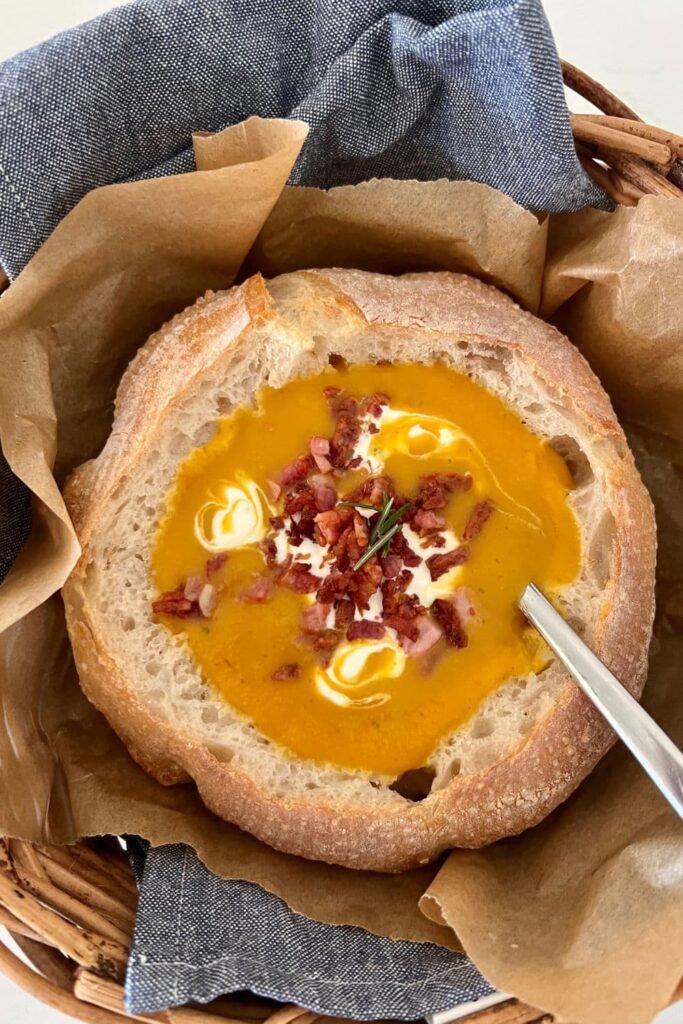
What Makes The Perfect Sourdough Bread Bowl?
The perfect sourdough bread bowl will have a round shape and a golden, blistered crust, strong enough to hold hot soup
I think the best thing about making sourdough bread bowls is that they don't have to be perfect! Because you are cutting the top and middle out of the loaves, you don't have to score them perfectly (that bit will be cut off and eaten with the soup!).
And remember, the more craggly, crunchy bits ... the better!
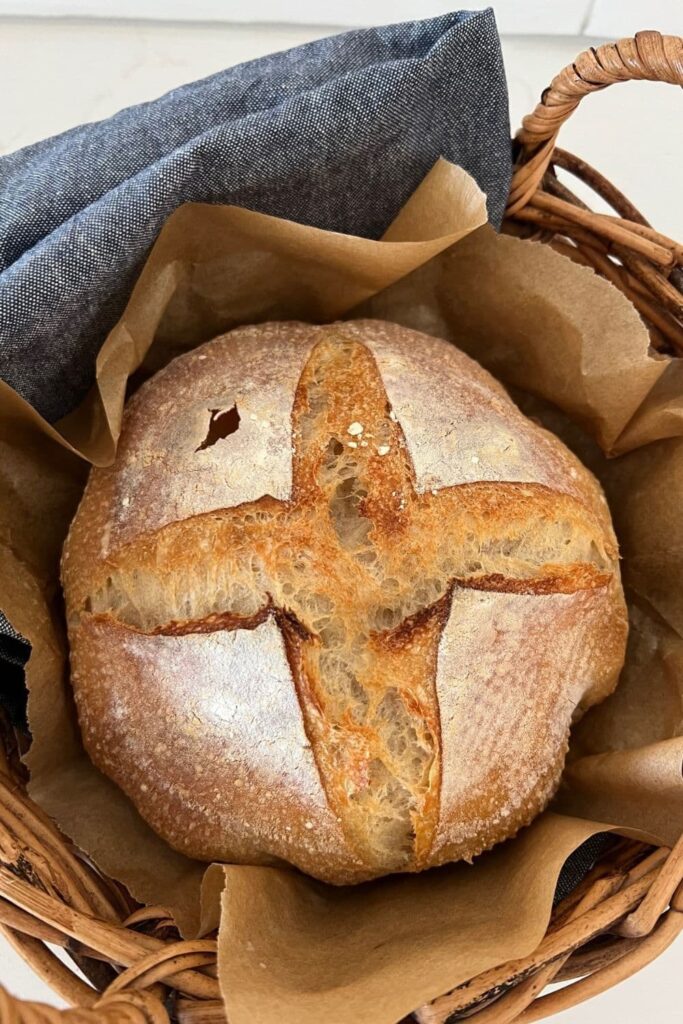
Should I Use Bread Flour or All Purpose Flour?
It's best to use bread flour to make these homemade bread bowls. Bread flour has a much higher protein content than all purpose flour and will give you a better rise and crust to your bread bowls.
You can read more about bread flour vs all purpose flour here.
How To Make Sourdough Bread Bowls
Making sourdough bread bowls is a fairly straight forward process, particularly if you have made a few loaves of sourdough bread before.
Before You Start
This recipe is for 2 sourdough bread bowls. Depending on how comfortable you are in dividing dough after bulk fermentation, you could choose to make the whole batch as one dough, or divide it into two smaller bowls if you prefer - it's up to you!
To make more than 2 sourdough bread bowls, simply multiply the recipe (ie for 4 bread bowls, double the recipe).
I highly recommend a good quality kitchen scale to ensure accuracy in this sourdough recipe.
Autolyse - Premixing The Dough
Weigh out your sourdough starter and water into a large mixing bowl.
Mix the water and starter together briefly. Then add your flour and salt and mix whole lot together to form a shaggy dough.
The dough will be fairly shaggy and only just brought together.
Cover your bowl with an elastic food cover and let it sit for around 1 hour. It's ok if it's a little bit longer, it's not going to matter too much.
This process is called the "autolyse" and allows your flour to soak in all the water and become hydrated.
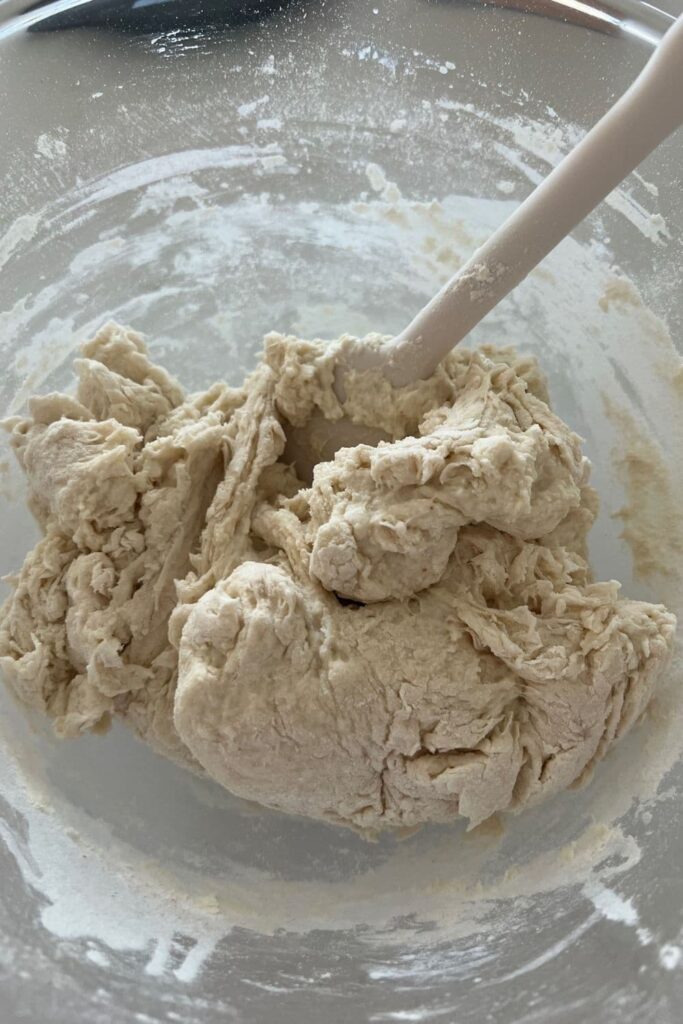
Forming Up The Dough
After the dough has been through autolyse you need to bring it together into a ball. Work your way around the bowl, grabbing the dough from the outside, stretching it up and over itself, into the centre, until a ball is formed. You shouldn't need more than about 20-25 stretches to form the ball.
You'll notice that the dough is fully hydrated after soaking all the water up. It will be fairly sticky but as you bring it into a ball, it will become smoother and shinier.
Once the dough has formed into a smooth ball, pop the cover back on and let it rest for 30 minutes.
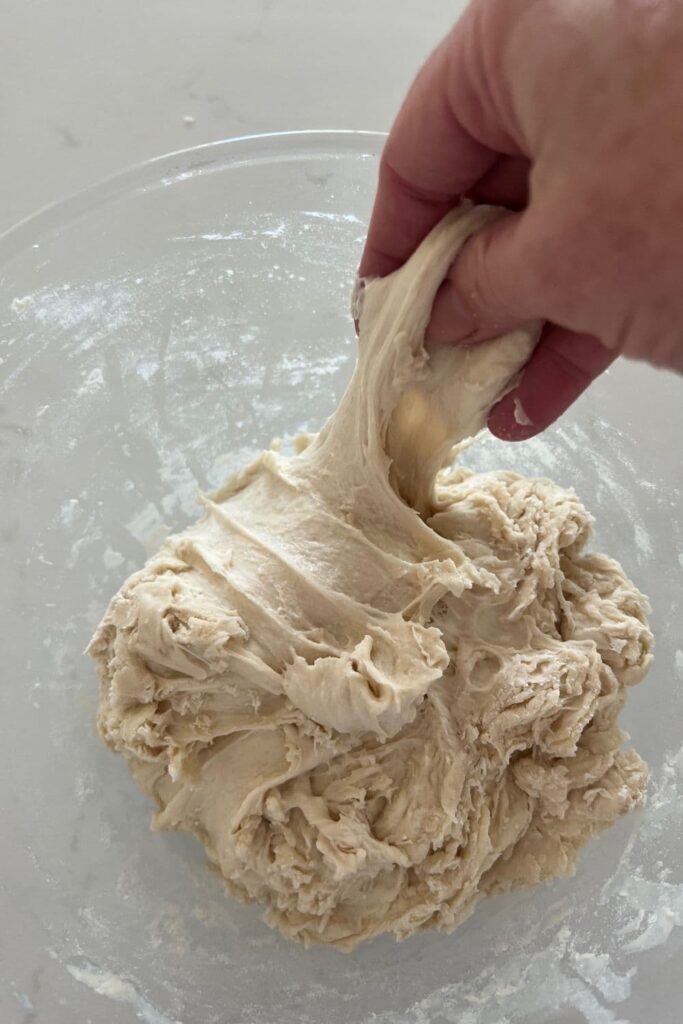
Stretch & Fold - Creating Structure
Over the next few hours you need to create some structure for your dough by "stretching and folding".
Aim to do around 4-6 sets of stretches and folds.
For each set, stretch the dough up and over itself 4 times. Leave around 15 minutes in between each set. Again you do not have to be exact with time, but you need to do at least 4 sets over 2 hours.
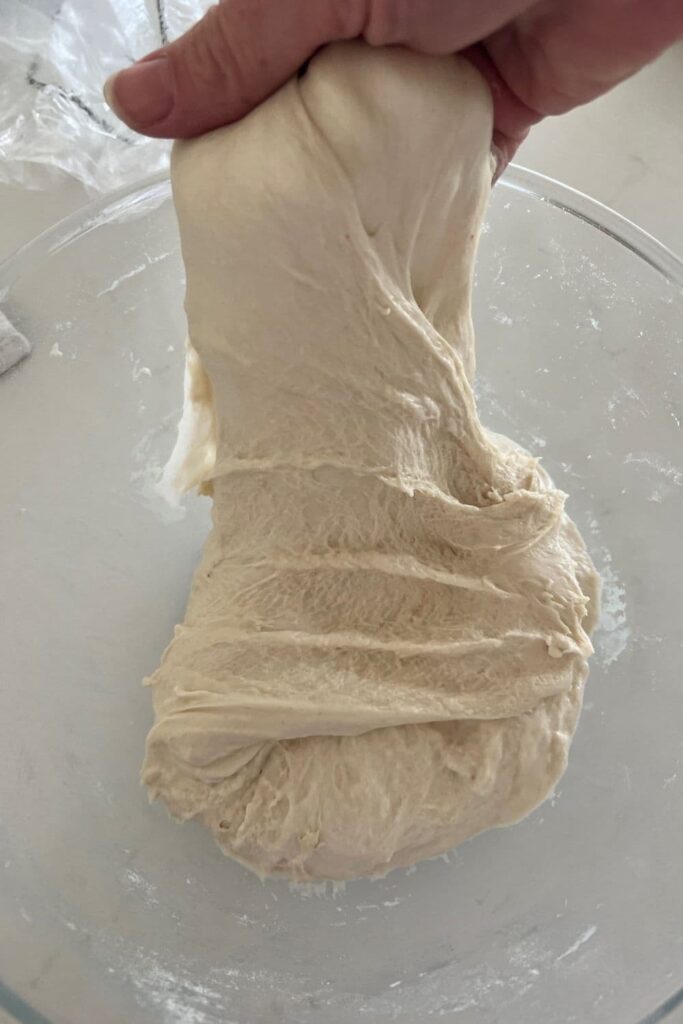
Bulk Ferment
Once you've finished your stretch and folds, cover the dough with a plastic cover (a recycled plastic bag is perfect) and allow the dough to double (bulk fermentation).
You can read more about bulk fermentation here.
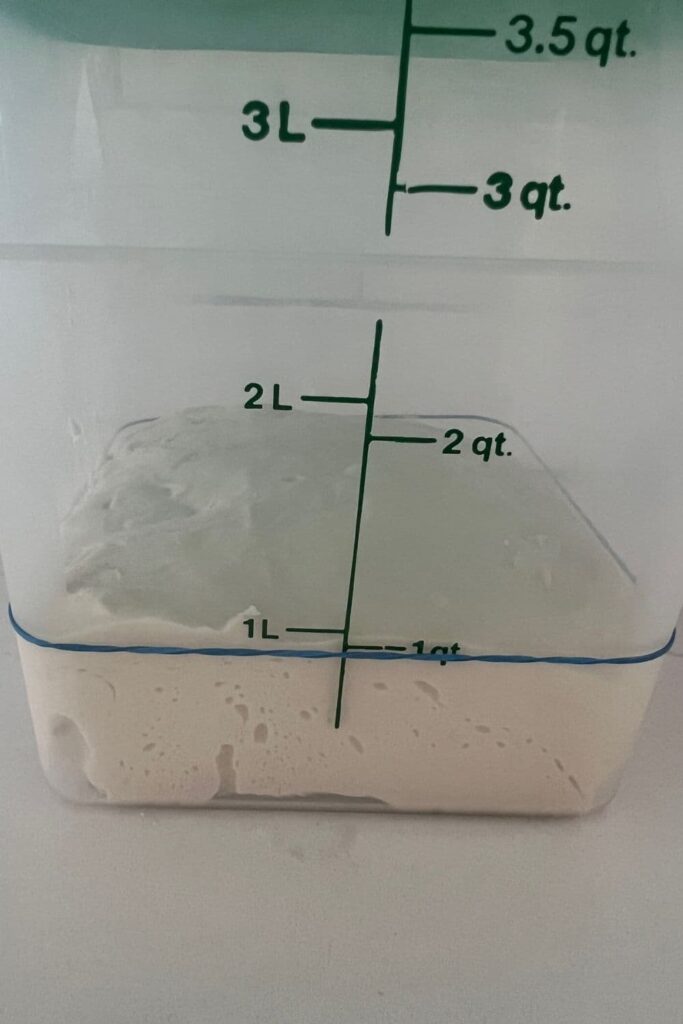
Shaping The Dough
Once your dough has finished its first ferment, it's time to shape your sourdough bread bowls.
You'll need to flour your counter top with rice flour for this (we use rice flour because it has no gluten). Try to be quite sparing with the rice flour, you only need a very light dusting.
Use a dough scraper to gently ease the dough out of the bowl (your hands work just fine if you don't have one). You want it to land upside down on your counter so that the smooth top of the dough is on the countertop and the sticky underside is facing up. This will make it easier to shape.
Divide the dough into two equal portions using a dough scraper (I weigh my dough to get them perfectly even, but you don't have to if you don't want to. Each piece of dough will be approx. 480g).
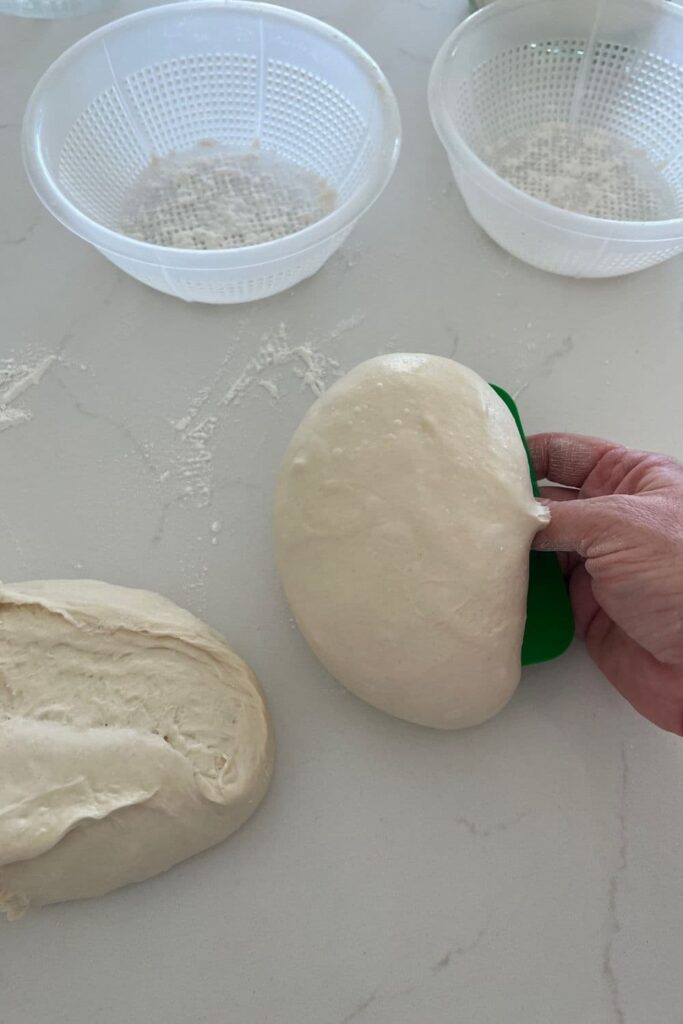
Take each piece of dough and bring the edges into the middle, forming a rough ball. Gently flip the dough over and then use the sticky side of the dough to tension it and form a perfect ball (it's just like shaping a mini boule).
You can see me shaping a boule here.
Placing Into A Proofing Container
Once the dough is shaped into a tight ball, place it into your proofing basket or container smooth side down, so your seam is on the top.
If you're using a cloth or tea towel in a bowl it's ok to put your dough with the smooth side up. Just make sure the dough is tight.
Lift your dough around the edges to pop a little more rice flour if you feel it needs it. Just try to handle the dough as little as possible and be really gentle as you really want to preserve all the gases and air bubbles that have formed during your bulk ferment.
For this recipe, I used two ricotta baskets and they worked really well - but you could use cereal bowls, small mixing bowls or whatever you have on hand.
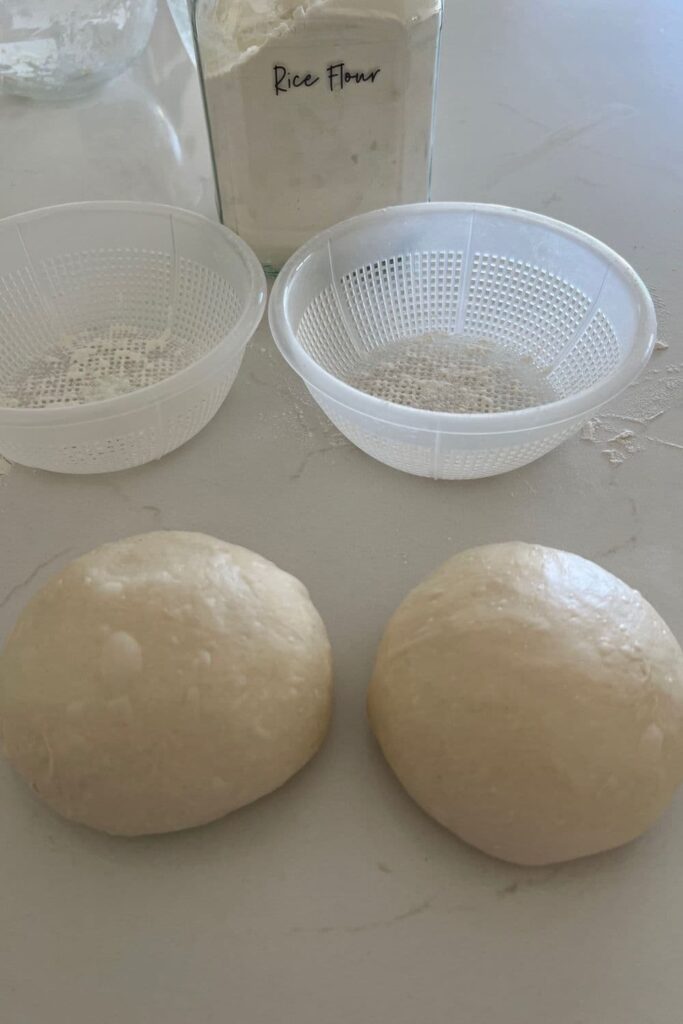
Cold Ferment
Now the dough is in its "shaping container" cover it loosely with a plastic bag and place into the fridge.
I use a large plastic bag to cover it - I just reuse it each time.
Try to leave it in the fridge for a minimum 5 hours up to a maximum of around 36 hours. The longer you leave it the better your bread will be! A longer cold ferment creates beautiful blisters on your crust and a deeper sourdough flavour.
Bake Your Sourdough Bread Bowls
Once you're ready to bake your sourdough, you'll need to preheat your oven to 230C/450F.
You can bake these sourdough bread bowls a number of different ways. If you have a Dutch Oven large enough to bake two at time, that's a great option. Otherwise, you can do an open bake on a large baking tray (depending on how many you are baking at time). I've added instructions for both methods below.
Leave your dough in the fridge until the very last minute - placing a cold dough into a hot oven will give you a great "spring".
When your oven is at temperature, take your sourdough out of the fridge. Gently place it onto a piece of parchment paper or silicone sling if using.
Gently score your bread with a clean razor blade or knife. At minimum a large cross is sufficient, but you can get as artistic as you like. You can find my full guide on how to score sourdough bread here.
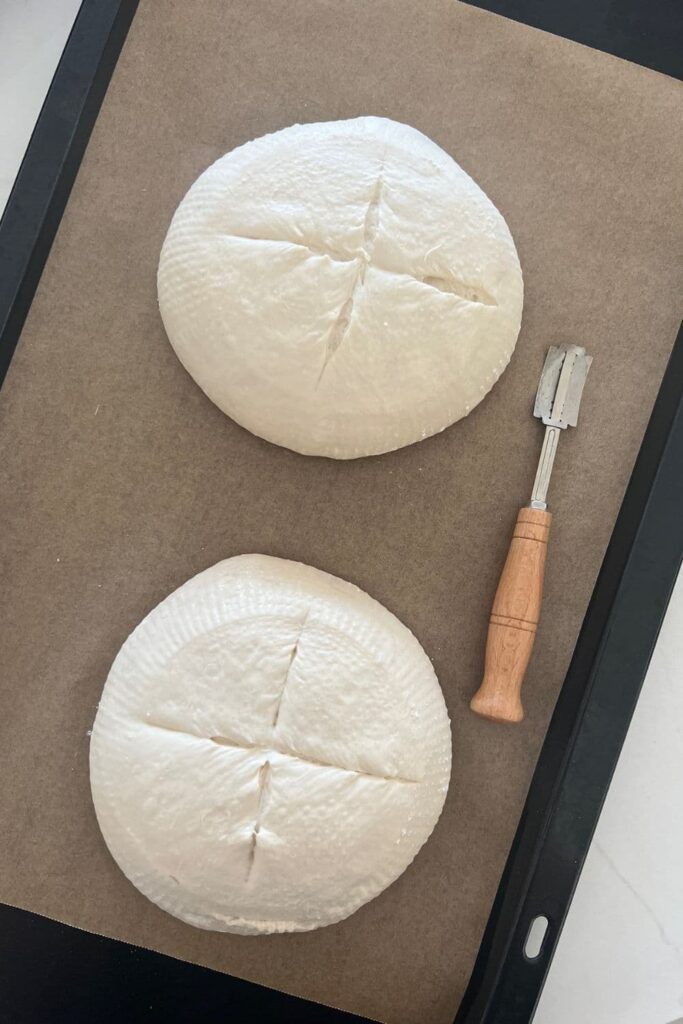
Bake Bread Bowls With A Dutch Oven
Carefully take your dutch oven out of the oven. Place the bread bowls into the pot using the silicone sling or parchment paper as a handle. Put the lid on and place into the hot oven.
If you want to you can spritz your dough with extra water before you put the lid on.
BAKE TIME:
30 Minutes with the lid on at 230C/450F plus
10-15 Minutes with the lid off at 210C/410F
Bake Bread Bowls Without A Dutch Oven
Once you're ready to bake your sourdough, you'll need to preheat your oven to 230C/450F.
Ensure that you have placed a baking stone in the oven if you are going to use one. For more information on baking without a Dutch Oven see here.
When your oven is at temperature, take your sourdough out of the fridge. Gently place your dough onto a bread peel or into your preferred baking method (enamel roasting pan/pot, casserole dish, stainless steel pot etc).
Gently score your bread with a clean razor blade or knife. It doesn't have to be perfect as you'll cut that piece off when you hollow out the loaves after baking.
Place your dough into the oven.
BAKE TIME:
20 minutes at 230C/450F plus
25 to 30 minutes at 210C/410F
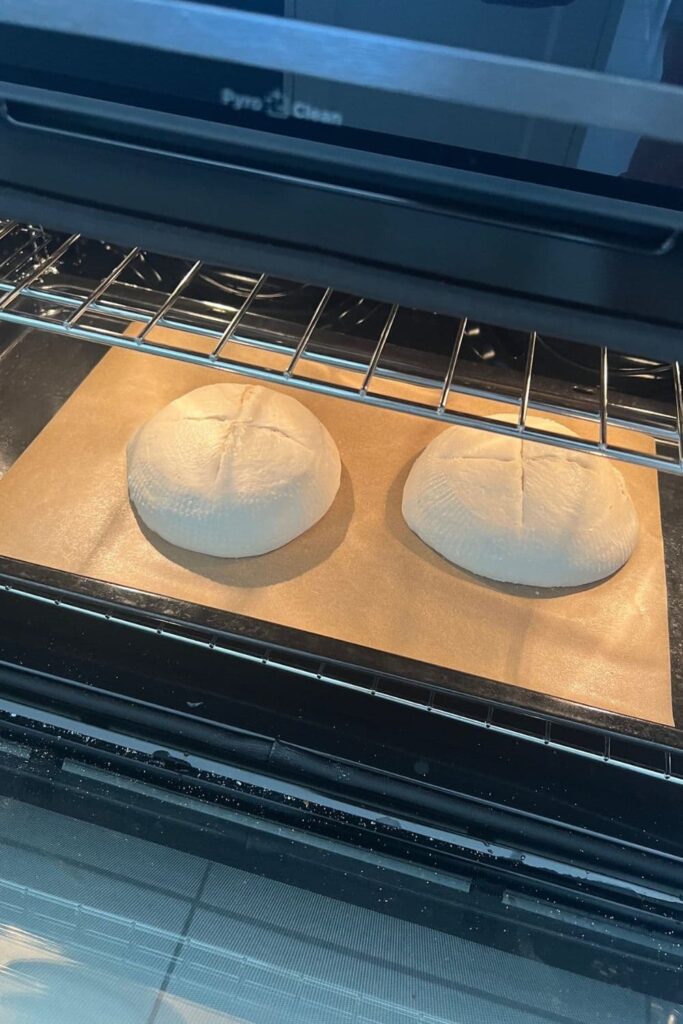
Finishing The Bake
Carefully remove your sourdough bread bowls from the oven and place them on a wire rack to cool. Don't attempt to hollow them out until they are completely cool or you'll get a gummy centre.
Cutting The Sourdough Bread Bowls
You'll need a small, sharp knife to cut the top out of the sourdough bread. I find it easier not to use a serrated knife for this part.
Once you've cut a neat circle, take the top off the loaf and set aside (this is great to dip into soup). Then use your fingers to hollow out the dough to form the "bowl". You can toast the dough chunks to use as croutons!
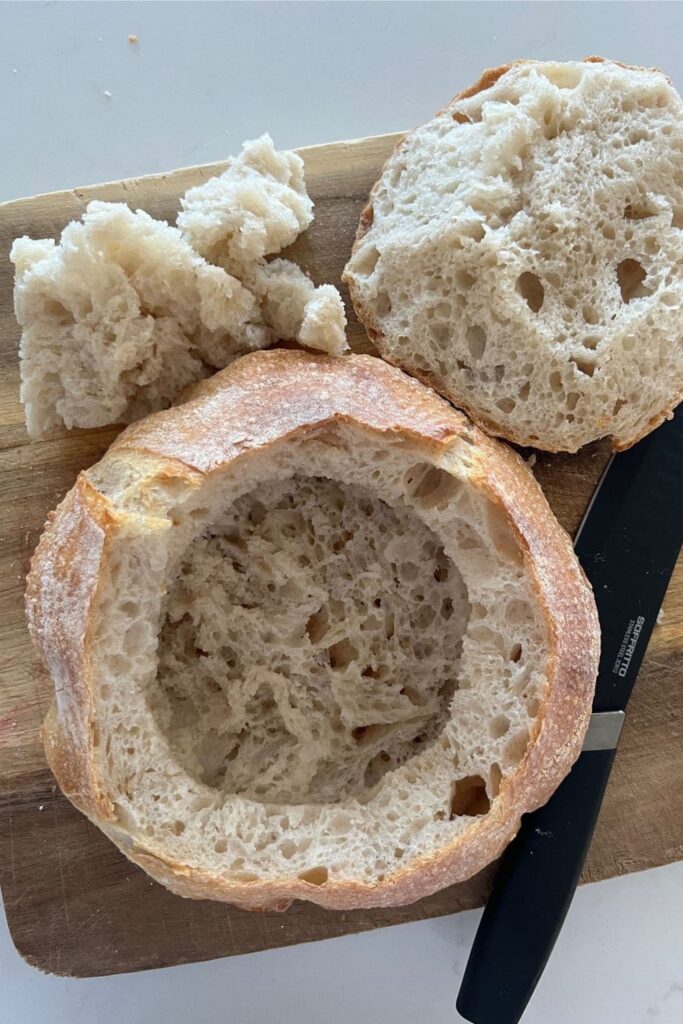
What To Use As Proofing Baskets for Sourdough Bread Bowls?
There are lots of things you can use as a proofing basket for these smaller sourdough bread bowls. You just need to have a look around the kitchen to see what you have on hand:
- ricotta baskets (the ones I use are 6"/16cm)
- cereal bowls
- soup bowls
- small mixing bowls
If you are making these sourdough soup bowls more often, you might like to invest in a set of smaller banneton baskets. I recommend these 6" banneton baskets.
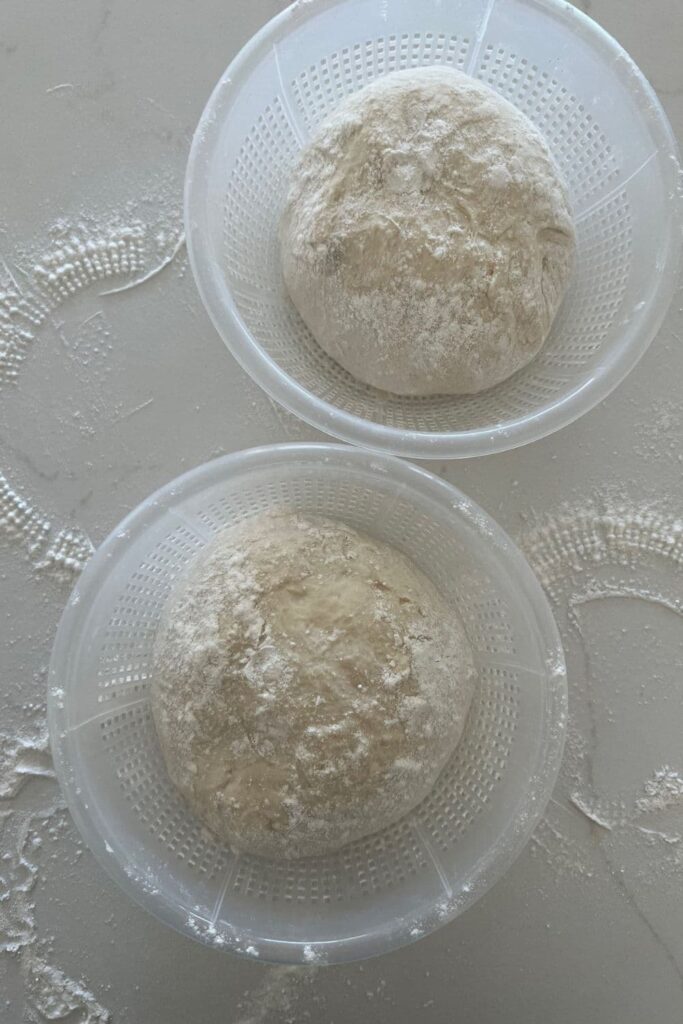
What To Serve In Sourdough Soup Bowls
My family's favorite soup is pumpkin - topped with lots of sour cream and crispy bacon. And it's much more fun when you can eat the bowl too!
Thicker soups work better than thinner soups in sourdough bread bowls. If the soup is too thin, it will leach into the bread too quickly and make it soggy.
Some other ideas for soups and stews to serve in your sourdough bread bowls are:
Clam chowder: This classic New England soup is a popular choice for serving in a bread bowl. The creamy, savory soup pairs perfectly with the crusty bread.
Chili: Thick and hearty chili is another great option for a bread bowl. The bread absorbs the flavors of the chili and adds a nice texture contrast.Broccoli cheddar soup: This creamy soup with chunks of broccoli and melted cheddar cheese is a favorite for many. Serving it in a bread bowl makes it even more delicious.
French onion soup: This soup, made with caramelized onions and topped with a layer of melted cheese, is a popular choice for serving in a bread bowl. The bread soaks up the savory broth and adds a satisfying crunch.
Tomato soup: This classic soup is simple yet satisfying, and serving it in a bread bowl adds an extra dimension of flavor and texture.
Spinach and artichoke dip: This creamy and cheesy dip is perfect for scooping up with bread, and serving it in a bread bowl takes it to the next level.
Beef stew: Hearty and comforting beef stew is a great option for a bread bowl. The bread soaks up the flavorful broth and adds a nice crunch. We love this sourdough Irish beef and Guinness stew.
Taco soup: This spicy soup made with ground beef, beans, and Mexican spices is a great choice for a bread bowl. The bread soaks up the flavors and adds a nice texture contrast.
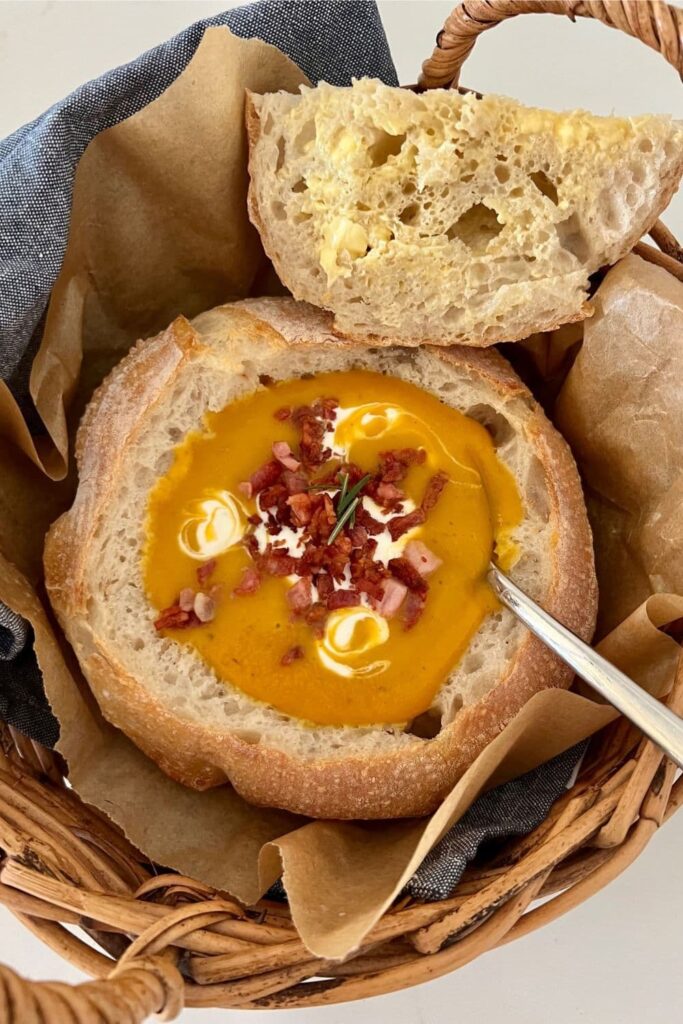
Frequently Asked Questions
You can egg wash your sourdough bread bowls before baking if you wish, but it's definitely not essential. Egg washing the bread bowls can make them burn more easily so you need to consider that before baking.
You don't need to toast the inside of the sourdough bread bowl before adding the soup (although you can if you want to). Sourdough bread is strong enough to hold up the heartiest of soups (although I do recommend a thicker soup, rather than a thinner soup).
Absolutely! These sourdough bread bowls are perfect for holding your favorite dip! I love making two bread bowls and filling each with a different dip (warm spinach and artichoke and a three layer mexican are my faves). You can even bake a few extra bread bowls and slice them up to dip inside - yum!


Sourdough Bread Bowl Recipe
Equipment
- Basic Kitchen Scale
- Small Banneton Baskets
Ingredients
- 500 g Bread Flour
- 350 g Water
- 100 g Sourdough Starter (Fed and Bubbly)
- 10 g Salt (increase or decrease according to your taste)
Instructions
- BEFORE YOU STARTThis recipe is for 2 sourdough bread bowls. Depending on how comfortable you are in dividing dough after bulk fermentation, you could choose to make the whole batch as one dough, or divide it into two smaller bowls if you prefer - it's up to you!To make more than 2 sourdough bread bowls, simply multiply the recipe (ie for 4 bread bowls, double the recipe).
- Autolyse - Premixing The DoughWeigh out your sourdough starter and water into a large mixing bowl - whatever you have in the cupboard is fine!Glass is always good as you can see what's happening underneath your dough. But any plastic, ceramic, stainless steel or glass bowl is fine! Mix the water and starter together briefly. Then add your flour and salt and mix whole lot together to form a shaggy dough. The dough will be fairly shaggy and only just brought together. You might wonder how this will turn into bread, but just wait, time is your friend and the dough will change in around an hour.
- Cover your bowl with an elastic foo cover and let it sit for around 1 hour. It's ok if it's a little bit longer, it's not going to matter too much.This process is called the "autolyse" and allows your flour to soak in all the water and become hydrated.
- Forming Up The DoughAfter the dough has been through autolyse you need to bring it together into a ball. Work your way around the bowl, grabbing the dough from the outside, stretching it up and over itself, into the centre, until a smooth ball is formed. You shouldn't need more than about 20-25 stretches to form the ball.You'll notice that the dough is fully hydrated after soaking all the water up. It will be fairly sticky but as you bring it into a ball, it will become smoother and shinier.
- Once the dough has formed into a smooth ball, pop the cover back on and let it rest for 30 minutes.
- Stretch & Fold - Creating StructureOver the next few hours you need to create some structure for your dough by "stretching and folding". Aim to do around 4-6 sets of stretches and folds. For each set, stretch the dough up and over itself 4 times. Leave around 15 minutes in between each set. Again you do not have to be exact with time, but you need to do at least 4 sets over 2 hours.
- Bulk FermentOnce you've finished your stretch and folds, cover the dough with a plastic cover (a recycled plastic bag is perfect) and allow the dough to double (bulk fermentation).See notes below for more info on this step.
- Shaping The DoughOnce your dough has finished its first ferment, it's time to shape your sourdough bread bowls. You'll need to flour your counter top with rice flour for this (we use rice flour because it has no gluten). Try to be quite sparing with the rice flour, you only need a very light dusting.Use a dough scraper to gently ease the dough out of the bowl (your hands work just fine if you don't have one). You want it to land upside down on your counter so that the smooth top of the dough is on the countertop and the sticky underside is facing up. This will make it easier to shape.Divide the dough into two equal pieces using a dough scraper (I weigh my dough to get them perfectly even, but you don't have to if you don't want to. Each piece of dough will be approx. 480g).Take each piece of dough and bring the edges into the middle, forming a rough ball. Gently flip the dough over and then use the sticky side of the dough to tension it and form a perfect ball (it's just like shaping a mini boule).You can see me shaping a boule here.
- Placing Into A Proofing ContainerOnce the dough is shaped into a tight ball, place it into your proofing basket or container smooth side down, so your seam is on the top.If you're using a cloth or tea towel in a bowl it's ok to put your dough with the smooth side up. Just make sure the dough is tight.Lift your dough around the edges to pop a little more rice flour if you feel it needs it. Just try to handle the dough as little as possible and be really gentle as you really want to preserve all the gases and air bubbles that have formed during your bulk ferment.For this recipe, I used two ricotta baskets and they worked really well - but you could use cereal bowls, small mixing bowls or whatever you have on hand.
- Cold FermentNow the dough is in its "shaping container" cover it loosely with a plastic bag and place into the fridge. I use a large plastic bag to cover it - I just reuse it each time. Try to leave it in the fridge for a minimum 5 hours up to a maximum of around 36 hours. The longer you leave it the better your bread will be! A longer cold ferment creates beautiful blisters on your crust and a deeper sourdough flavour. It will also ensure your dough forms a skin which makes it easier to score.
BAKE YOUR SOURDOUGH BREAD BOWLS!
- Once you're ready to bake your sourdough, you'll need to preheat your oven to 230C/450F. You can bake these sourdough bread bowls a number of different ways. If you have a Dutch Oven large enough to bake two at time, that's a great option. Otherwise, you can do an open bake on a large baking tray (depending on how many you are baking at time). Leave your dough in the fridge until the very last minute - placing a cold dough into a hot oven will give you a great "spring".When your oven is at temperature, take your sourdough out of the fridge. Gently place it onto a piece of parchment paper or silicone sling if using. Gently score your bread with a clean razor blade or knife. BAKE WITH DUTCH OVENCarefully take your dutch oven out of the oven. Place the sourdough into the pot using the silicone sling or parchment paper as a handle. Put the lid on and place into the hot oven. If you want to you can spritz your dough with extra water before you put the lid on.BAKE TIME:30 Minutes with the lid on at 230C/450F plus10-15 Minutes with the lid off at 210C/410F
- OPEN BAKE WITHOUT DUTCH OVENOnce you're ready to bake your sourdough, you'll need to preheat your oven to 230C/450F. Ensure that you have placed a baking stone in the oven if you are going to use one. For more information on baking without a Dutch Oven see here.When your oven is at temperature, take your sourdough out of the fridge. Gently place your dough onto a bread peel or into your preferred baking method (enamel roasting pan/pot, casserole dish, stainless steel pot etc).Gently score your bread with a clean razor blade or knife. At minimum a large cross is sufficient, but you can get as artistic as you like. You can find my full guide on how to score sourdough bread here.Place your dough into the oven.BAKE TIME:20 minutes at 230C/450F plus25 to 30 minutes at 210C/410F
- Finishing The BakeCarefully remove your sourdough bread bowls from the oven and allow them to cool completely before you try to hollow them out.
- Cutting The Bread BowlsYou'll need a small, sharp knife to cut the top out of the sourdough bread. I find it easier not to use a serrated knife for this part. Once you've cut a neat circle, take the top off the loaf and set aside (this is great to dip into soup). Then use your fingers to hollow out the dough to form the "bowl". You can toast the dough chunks to use as croutons!
Notes
- Notes on Flour: This recipe is written using strong Bread Flour. Bread flour has a higher protein content than All Purpose flour. If you choose to use All Purpose flour you may have a different result because of this. You can read more about the differences between All Purpose Flour and Bread Flour here.
- Notes on Sourdough Starter: This recipe is based on you having an active starter that you have fed a few hours before starting your bake. For info on how to make a sourdough starter, go here.
- Notes on Stretch & Folds: If you are going to do the stretch & folds on your bench top, spray your surface with water mist rather than using flour. You can leave the dough in the bowl if you want to. Wet your hands to stop the dough sticking - although it shouldn't be too sticky. It will get less sticky as you do your stretches and folds. For more information on how to do stretch and folds, go here.
- Notes on Bulk Fermentation: If your home is warm then your dough will ferment a lot faster and could be done in as little as a few hours. If it's colder, it will take longer, possibly overnight.
I would recommend that you try to do your first few bulk ferments during daylight hours so that you can watch your dough closely.
Once you're more familiar with the process - and the temperature of your home - you will be able to do overnight ferments. You will know your dough is ready to move to the next stage when it has *just* doubled in size. It will be fairly wobbly and full of bubbles. You should be able to see large air bubbles under the surface of the dough.
You don't want to let it go any further than doubled as it will be over fermented.
If you want to do an overnight ferment, but your home is warm, consider using a little less starter (ie 25g).
Less starter means your dough will take longer to ferment and you will reduce the risk of over fermenting your dough. You'll find more information on these topics here:
When is my bulk ferment finished? What is the difference between cold ferment and bulk ferment? Why does the amount of starter matter?
- Notes on Baking: If you're worried about the base of your bread burning, place a baking sheet on shelf underneath your Dutch Oven - it works! If you're worried about your bread not being cooked all the way through, turn the oven off and place your dough straight onto the oven rack. Leave the door ajar and let your bread rest there for a few hours. Make sure you don't close the door or your sourdough will sweat and you'll get a wrinkly, soggy crust. Remember not to cut into your loaf too soon - you'll need to let it cool for at least a few hours (4-6 is best).
Nutrition




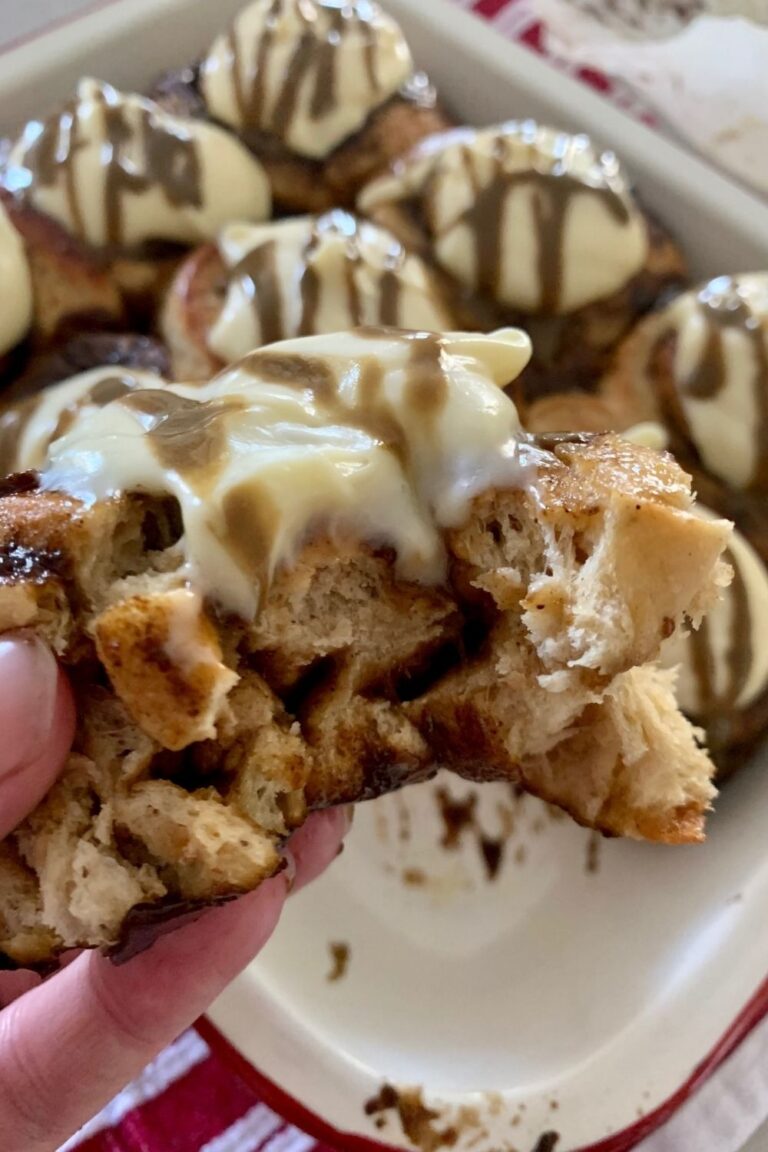
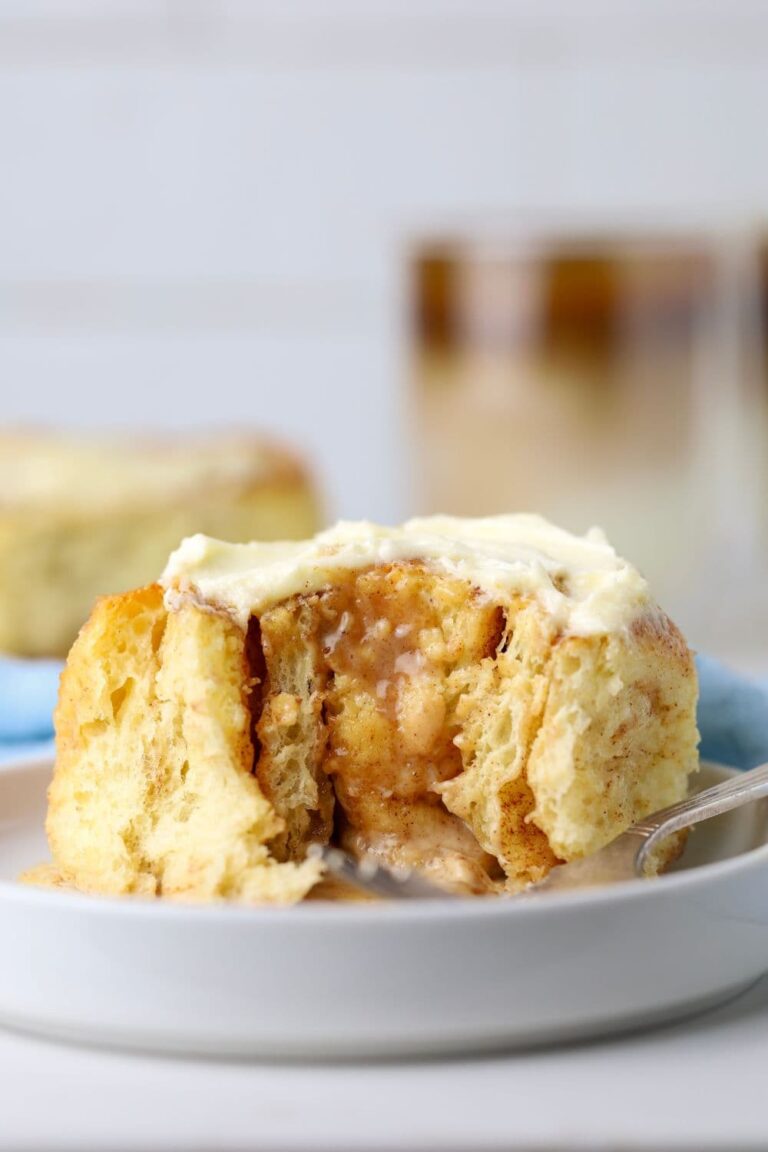
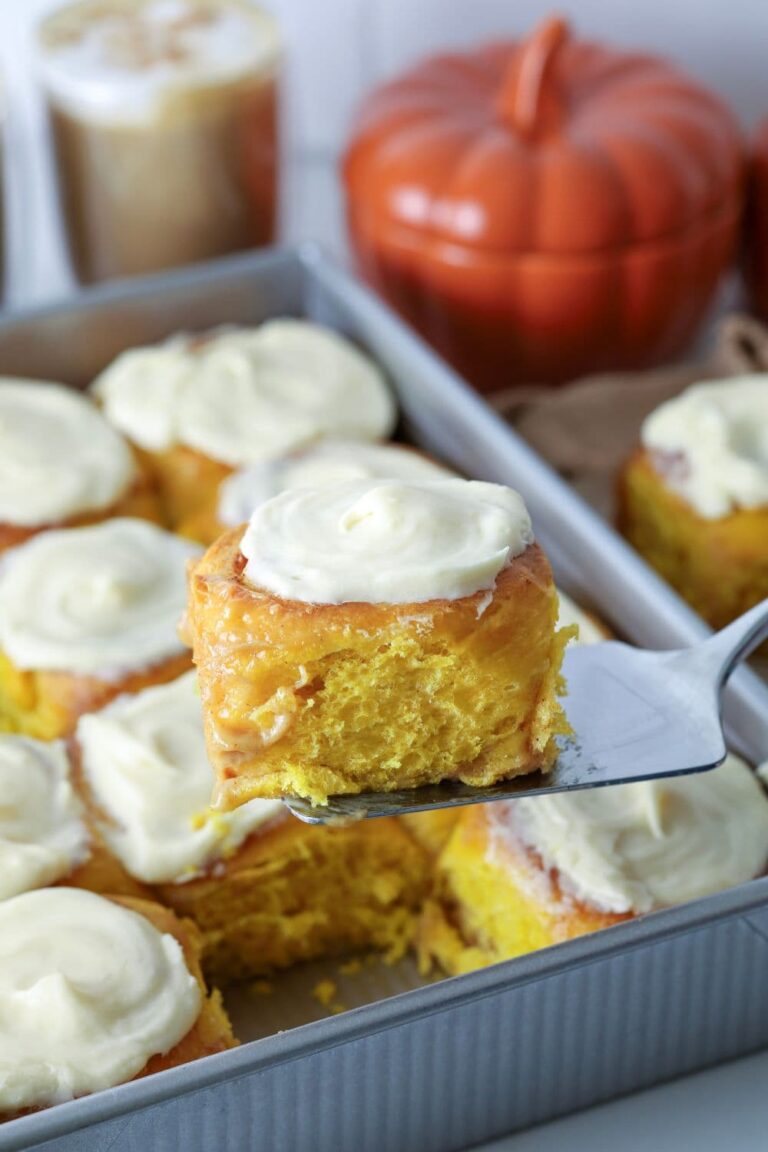

I think this will be the perfect recipe for our Christmas Eve soup bowls. Since I'll be cutting out the centers, I should only need a small cut for steam to escape? May I make them ahead and freeze them? How should they be wrapped to keep a few weeks in the freezer? I need to make 25 bread bowls. Thank you.
Made these fairly early in my sourdough bread making journey and they turned out AMAZING. I split one bread bowl in half before proofing and this made 2 bowls at a perfect size for our kiddos. Thank you for the great step by step instructions! Definitely making these again very soon!
Can the bread bowls be frozen after the cold proofing?
I don't recommend this - I prefer freezing after baking and cooling. You can see Kate's tips for freezing sourdough bread here.
Do you have to use a specific size banneton for the bread bowl shape? Or will any boule banneton work? I am so excited to try these!
I overproofed the dough (just didn't get around to baking when I should have) but these were still so delicious! I split the recipe into thirds, and next time will make 4 bowls. The loafs are much bigger than we need, especially when served with a hearty chowder.
I don't have a steam option on my oven. And my dutch oven isn't large enough for two loaves. What do you suggest? Thanks!
You can just open bake these on a cookie sheet or even a pizza stone if you have one. You can add some steam to your oven but it's not essential.
Thank you for all of your tips and recipes, all has been very helpful. I just completed the bread bowl recipe, once in a DO, the other half in an older Al Dutch oven with a flatter lid, That came out flatter. Next will try the same plan baking on a pizza stone with a hot water in an old heated cast iron oven skillet for steam, and spritz the loaves at the end with water.
Literally my go-to for bowls and full loaves. Always results in awesome flavor, crumb, everything!
We love that! Thank you, Leah!